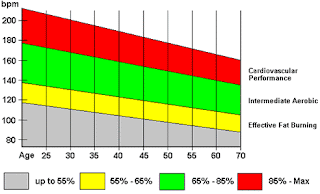 |
| average pulse rate by age |
About Average Pulse Rate
The easiest tool to determine the count of heart beat is pulse rate. When our heart have some malfunction, pulse rate is used to assess special procedures. For example, controlling your high blood pressure is ensured by keeping a record of your pulse rates. To determine high blood pressure, pulse rates can be taken from any parts of the body with the wrist as the most preferred. All that is needed is a watch or clock with a second hand
Pulse beat, rhythm and volume are three important characteristics that you must know. Rhythm is the time interval between heart beats and volume is the strength of the heartbeat. Below are the average pulse rate by age.
Newborn 120 – 160, Average Pulse Rate 140
Toddler (1-2 years) 90 – 140, Average Pulse Rate 115
Pre-School (3-5 years) 80 – 110, Average Pulse Rate 95
School age (6-12 years) 75 – 105, Average Pulse Rate 90
Adolescent (13-18 years) 60 – 100, Average Pulse Rate 80
Adults 60 – 100, Average Pulse Rate 80
Seniors (over 60 years) 67 – 80, Average Pulse Rate 74
Toddler (1-2 years) 90 – 140, Average Pulse Rate 115
Pre-School (3-5 years) 80 – 110, Average Pulse Rate 95
School age (6-12 years) 75 – 105, Average Pulse Rate 90
Adolescent (13-18 years) 60 – 100, Average Pulse Rate 80
Adults 60 – 100, Average Pulse Rate 80
Seniors (over 60 years) 67 – 80, Average Pulse Rate 74
What factors that can affect average pulse rate ?
The pulse rate is affected by many factors age, gender, Physical activity , Emotional activity, Illnesses, and Metabolism. Pulse rate decreases when we grow older, sleep will decerase pulse beat, fear, anger, excitement and anxiety will cause sudden rise of pulse, fever and other viral diseases will make your pulse rate faster, pregnancy, hyperthyroidism and infection will increase the pulse.
If one is consistent in getting the pulse rate at the same time each day, this can be used as a basis in setting up a basis for medications or disease monitoring or even exercise program. An exercise program, attaining an ideal weight and improved diet can reduce resting pulse rate. Always start on a slow exercise with proper doctor consultation. Also meditation or mental conditioning can reduceaverage pulse rate
But there is some of of pulse abnormalities are called Bradycardia where average pulse rates are 60 and below, on the other hand, people who has an above normal pulse rate are called Tachycardia. Pulse that exceeds 90 or more are considered to have this type of pulse. Tachycardia constitutes to body illnesses specially heart disease.
Another abnormalities is Arrythmia or Cardiac Dysrythmia when our heart has skipping beats or irregular time interval between beats. The heart beat may be too fast or too slow, and may be regular or irregular.




